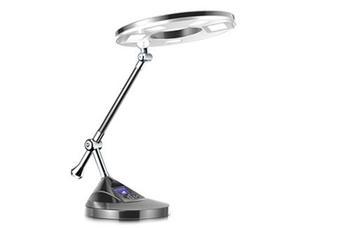Eye protection depends on the shading
 Recently, among the 14 unqualified lamps and lanterns announced by the Beijing Municipal Administration for Industry and Commerce, the "eye protection lamp" and "eye protection lamp" accounted for nearly 1/3. Many businesses have claimed that "high-frequency flash" or even "no flash" can protect eyesight, and even some businesses claim that the product is "DC power supply is healthier." Others have pointed out that eye protection lamps are only concept products. In the end, whether products have achieved the “eye protection†effect? ​​Experts said that strobe light has not been classified as an indicator of eye protection, and “shutter performance†in the national standard is the “eye protection†of eye lamps. "key.
Recently, among the 14 unqualified lamps and lanterns announced by the Beijing Municipal Administration for Industry and Commerce, the "eye protection lamp" and "eye protection lamp" accounted for nearly 1/3. Many businesses have claimed that "high-frequency flash" or even "no flash" can protect eyesight, and even some businesses claim that the product is "DC power supply is healthier." Others have pointed out that eye protection lamps are only concept products. In the end, whether products have achieved the “eye protection†effect? ​​Experts said that strobe light has not been classified as an indicator of eye protection, and “shutter performance†in the national standard is the “eye protection†of eye lamps. "key. Strobe not included in table lamp indicator requirements
The concept of “eye-protection lights†has a long history. Many businesses use “high frequency flash†and “no flash†to indicate that their own lamps are not only “eye-woundedâ€, but also able to protect their eyesight and even prevent myopia. ". In recent years, there are businessmen who claim that their lamps belong to “DC power supply†and are healthier than the “AC-powered lamps†in the past. Is this true?
Yang Zheng introduced that "DC power supply" if it is clear that the current of the lamp is operated in a purely DC mode, the light emitted by the light source will also be in the form of a direct current (superimposed on the DC basis with slight fluctuations or pulsation) from the physical In terms of the angle, the fluctuation of the light emission is indeed much lower than the fluctuation of the light emission of the light source operated by the alternating current. At present, a table lamp using an LED light source module belongs to this type, but its input power supply is still in the form of communication.
However, Yang Zheng explained that in fact, "the human eye is sensitive to the frequency of light fluctuations in the low frequency range." Such as ambulances and other warning lights, the frequency is about 8-10 Hz, the most vulnerable to eye discomfort, causing everyone's vigilance. These frequencies are much lower than the optical frequency range of the light source of normal AC power supply work, so “there is no situation where the eyes of normal people are uncomfortable when the light source is operating at the current frequency of civil power supplyâ€. For example, he said that the light sources used worldwide for a wide range of light sources are 50-60 Hz. Since there is no low frequency eye injury, there is no such thing as high-frequency eye protection.
In addition, the reporter consulted the national standard “performance requirements for reading and writing desk lamps†as a national standard “applicable to reading and writing lighting used in places like homes, classrooms, etc.†and the standard did not mention the so-called strobe issue. According to the reporter’s understanding, in the draft of the standard, the preface mentioned that “currently, high-frequency scintillation (flicker greater than the frequency of fusion) affects the results of visual research. It is not yet certain that retinal nerves are caused by high-frequency light stimulation. The response will affect the visual function of any sensory or motor nerve, so this standard does not include the technical requirements of the table lamp."
Two factors determine the eye of the lamp or not
Most of the so-called "eye-protection lights" are ordinary desk lamps. The reporter learned that the national standard "performance requirements for reading and writing desk lamps" has made provisions for table lamps from eye-related item indicators, such as: specifying the requirements for the color characteristics of the light source and the color rendering index (5.7.2), noise requirements (5.10) and so on.
The standard also stipulates the requirements for shading of lamps (see 5.8.1, “The height of the eye from the reading and writing tabletop is 400mm, and the horizontal distance from the center of the light source is 600mm toward the lamp. The reflector's inner wall and light source should not be seenâ€. Yang Zheng explained that the light emitting surface cannot be projected into the retina of the human eye. This is the true eye protection requirement of the table lamp.
Another related to “eye protection†is the “illuminance requirement†(5.8.2). This standard requires that the lighting of the table lamp on the desktop should be relatively uniform, and the lighting area should cover the area of ​​reading and writing, otherwise it will cause visual fatigue.)
The shipboard medium voltage power cables are intended for shipboard and off-shore building to transmit power.
Standards applied: IEC60092-350, IEC60092-354, IEC60092-360, IEC60228, IEC60332-1-2, IEC60332-3-22, IEC61034, IEC60754 and IEC60684-2.
Product making: factory name, type, rated voltage core.
Making: colour tape.
Medium Voltage Marine Power Cable
Different Types Of Electrical Cable,Medium Voltage Marine Power Cable,Electrical Marine Power Cables,Marine Control Power Cable
Jiangsu Jiangyang Special Cable Co,.Ltd. , https://www.jymarinecable.com